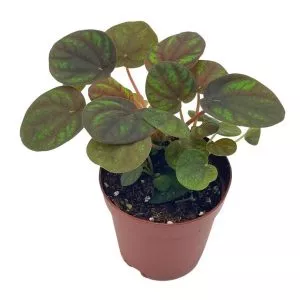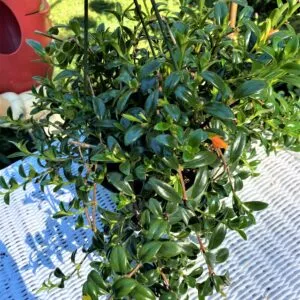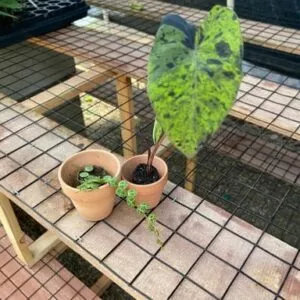No products in the cart.
Table of Contents
When you hear the term dunce cap, the first thing coming to mind is someone who has been naughty and sits in a corner, as no person is stupid but might be a slow learner. Yet, why would someone give a succulent plant that name?
Well, the dunce cap or Chinese dunce cap with the fancy botanical name Orostachys malacophylla var iwarenge has silvery lavender cone-shaped rosettes that look like a dunce cap. Hence, the odd name.
The plant spreads through slender runners that form offsets and fall off, taking root to develop new plants. Plus, those pointy cones form small flowers, and a bonus is it makes for excellent ground cover or looks fabulous in rock gardens.
Chinese Dunce Cap Succulent Plant Care
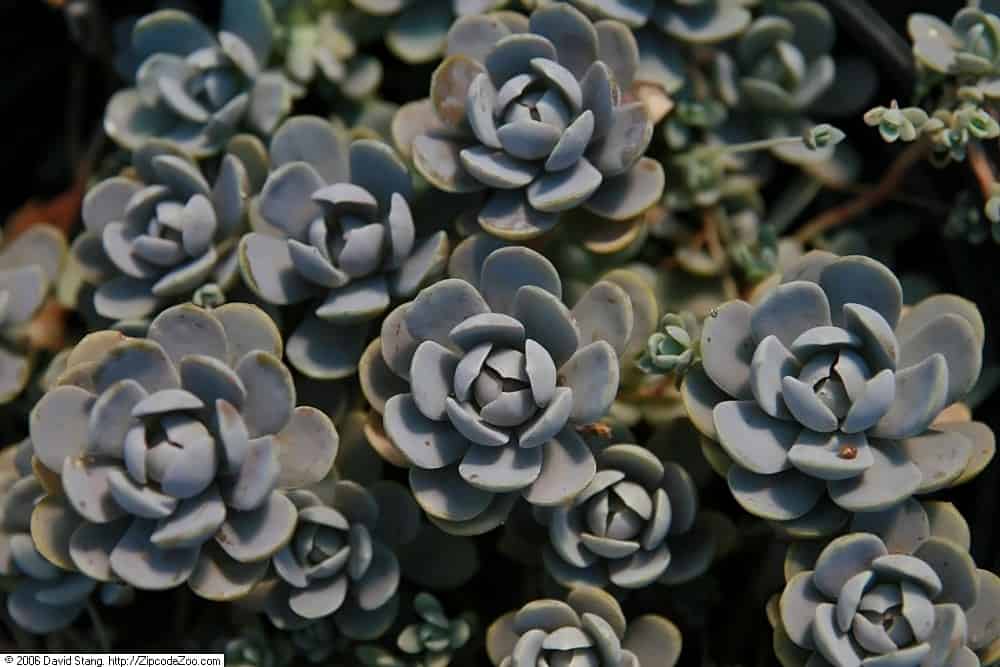
The Chinese dunce cap succulents grow quickly and also propagate with ease. The long fall bloom stalks can reach up to six inches producing white or yellow flowers. It is a delicate soft succulent native to Northern China, the Japanese alps, and Mongolia.
When you live in the USDA hardiness zones five to ten, you can grow them outdoors year round as they can tolerate frost becoming dormant in winter. In addition, these succulent plants are drought tolerant but need more water in the growing season.
As gorgeous as it looks in the landscaping, they also thrive in patio containers provided with the proper care conditions.
Soil Mix Suitable for Dunce Cap Succulent
The Chinese dunce cap needs well-drained soil planted indoors or outdoors for succulent gardens. For indoor plant growing, we recommend using a container with enough drainage holes as it is essential to prevent root rot.
The Orostachys prefer ample air circulation with not too much humidity. The best regular potting mix is coarse sandy soil and grit, or you can invest in a cactus or succulent potting medium.
So coarse sand with added grit is all you need to keep this plant happy even when grown on border edges. Thus, the Orostachys iwarenge can adapt to nutrient-rich and nutrient-poor soil like sandy soil to clay soil.

But with clay soil, you will need to add some extra grit to keep it airy and light.
Sunlight Needs for Chinese Dunce Caps
Your Chinese dunce cap succulents love bright sunlight but cannot stand excessive heat or direct sunlight. Too much sun will cause leaf burn, and if you live in warm environments, it is best to provide your Orostachys malacophylla var iwarenge with some shade.
You can provide your plant light sun but not direct sunlight when grown indoors.
Deep Watering Needs
The best time to water your Chinese dunce cap succulents is in the morning, allowing the fleshy leaves to dry out during the day. The best is to avoid wetting the leaves as it can damage them.
As with most plants, the dunce cap needs watering when you notice the first inch of soil dry to touch. You can then do a soak and dry method to prevent overwatering. Orostachys malacophylla var iwarenge is a drought-tolerant plant.
But with high levels of humidity, it becomes fatal for this plant. Your new plants will need more water daily for the first few weeks. Once your plant adjusts to the environment, you can water it as usual.
Yet, it helps to remember that sandy soils dry out faster while clay soils hold moisture. Another notable thing is not applying water directly to the root zone, as they can rot quickly. A great way to water your plant outdoor is hand watering using a watering wand.
For container watering, allow the water to drain freely from the pot and remove the excess water from the catch saucer.
Temperature & Humidity Needs
The Orostachys iwarenge is one of the few succulents growing in the Asian continent as they thrive in frigid mountainous regions.
The plant is a monocarpic succulent, meaning they live in a perpetual life and death cycle as each rosette dies after the blooming period but produces loads of offsets that continue the cycle.
Hence, they can withstand temperatures as low as minus 10 degrees Farenheight. But they prefer a low humidity compared to a high one.
Fertilizing of Dunce Cap Succulent
During the growing season in spring to late summer, you can provide your Orostachys malacophylla var iwarenge with a low nitrogen fertilizer once or twice.

Using liquid feeds is best when watering your plant. It will provide your pot-filled plant with the nutritional balance needed for new growth and encourage blooming.
Pruning Dunce Cap Succulent
The Chinese dunce cap succulents grow fast, and you might need to prune them often. You can remove the faded flowers, but it is best to wait for the blooming period to end before removing the whole flower stalk.
Once the flower withers and you remove it, the energy directs towards growing new leaves instead of leading to seed production.
Chinese Dune Cap Propagation
The Chinese dunce cap produces a lot of pups making propagation easy. You can do this using the division method by removing offsets with a rooting system. Use a clean, sharp knife to cut through the roots to plant in a pot filled with well-drained soil or directly in your garden.
Orostachys Varieties
When it comes to the Chinese dunce cap, you can find some other interesting succulent plants in the Orostachys genus.
Orostachys spinosa

The plant is native to Mongolia and can withstand cold weather, from freezing temperatures to snow. The fact is that this plant survives freezing temperatures and still photosynthesizes when under the snow.
Orostachys minuta

This one is smaller than most other succulents, with a colossal rosette in a bright green color.
Orostachys thyrsiflora
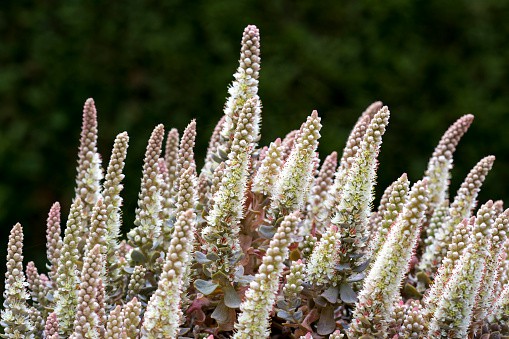
Out of all the succulents, this is the most evil-looking plant in the tribe. It has long, pointed leaves on the outer side that guards the inner center with spikey foliage.
Dunce Cap Succulent Diseases and Pests
When you grow your Orostachys malacophylla var iwarenge indoors, it is not as susceptible to mealybugs as outside. The best thing is to keep an eye on these bugs when you notice a waxy cotton substance propagating your plant.
You can remove them with a toothpick, and if visible, use an insecticidal soap spray or even isopropyl alcohol. Still, we do not recommend spraying your plant if it has sat in full sun as it can damage the leaves.
Frequently Asked Questions
The Chinese dunce cap is a must-have plant for the winter as it is a hardy succulent that grows as a perennial to grow outside. But, as with most plants, it helps protect them against the icy cold.
Yes, the plant is monocarpic as it produces many offsets with long stolons growing and has spread growth working well as ground cover. The rosettes bloom once and die while the pups live on.
The plant needs bright light and feeds only during the growing seasons using a low-nitrogen fertilizer. Your plant can thrive on infrequent watering only when the soil is dry to the touch. The best time to water is in the morning, leaving your plant to dry out before the evening arrives.
The fantastic news is that the dunce cap is not a rare plant and is found at your local nursery. But the other good news is you can find one with Plantly here.
Whether you want to buy, sell or simply reach out to other plant enthusiasts, Plantly is the right place to be!
In stock In stock In stock In stock
$6.99
Sold By:
BubbleBlooms
Red and Green Ripple Peperomia Frost, 2 inch, (brownish) Emerald Ripple Pepper, caperata, albovittata
Only 99 available and it’s in 3 people’s basket Rated 4.81 out of 5 based on 279 customer ratings00
Sold By:
BubbleBlooms
$9.99
Sold By:
Cacti and Exotica
Notocactus scopa—Silver Ball Cactus
Rated 4.98 out of 5 based on 59 customer ratings00
Sold By:
Cacti and Exotica
$25.00
Sold By:
Painted Petals and More
Goldfish Plant–Columnea
Rated 4.78 out of 5 based on 64 customer ratings03
Sold By:
Painted Petals and More
$24.95
Sold By:
Wonka Plants
$26.00Colocasia – Mojito – Starter Plant
Only 23 available and it’s in 3 people’s basket Rated 4.94 out of 5 based on 108 customer ratings39
Sold By:
Wonka Plants
